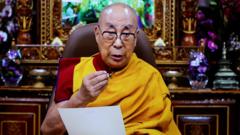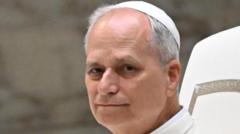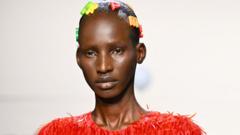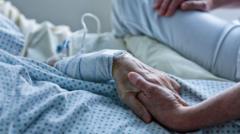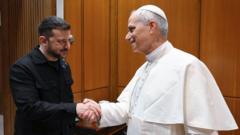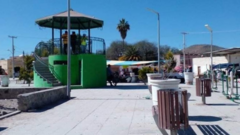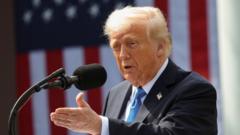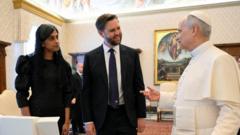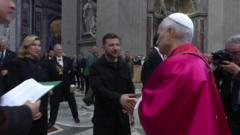Ahead of the upcoming conclave, discussions reveal a spectrum of priorities shaped by Pope Francis's legacy and the global landscape of the Church.
**Divisions and Dynamics Within the Vatican as Conclave Approaches**
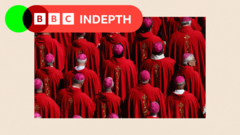
**Divisions and Dynamics Within the Vatican as Conclave Approaches**
As cardinals prepare to elect a new Pope, underlying tensions and diverse perspectives emerge at the Vatican.
The Vatican's Santa Marta guesthouse, which features 128 rooms, is about to become a hub of activity as cardinals gather for the conclave to select the next Pope starting May 7. One room, however, remains sealed with a red ribbon as a solemn tribute to its last occupant, a reminder of the profound legacy of Pope Francis, who led the Catholic Church for 12 transformative years.
Pope Francis appointed around 80% of the cardinals participating in the conclave, meaning his influence looms large over the election. His tenure was marked by a radical shift in the Church’s focus—steering it towards the needs of the poor and marginalized while seeking to engage the laity more actively in Church affairs. Conversations with cardinals reveal a struggle to balance the necessity of building on Francis's achievements and addressing critiques from traditions that favor a more conservative approach.
The upcoming conclave stands out as the most diverse in the Church's history, with unprecedented representation from countries such as Cape Verde, South Sudan, and Papua New Guinea—all regions attempting to integrate their unique challenges into the broader conversation. Discussions are intensifying about the varied challenges impacting the Church globally: while European cardinals discuss relevance amid declining congregations, their African and Asian counterparts grapple with social conflicts and poverty.
As the cardinals convene for preparatory meetings leading up to the conclave, the choice before them becomes clear. They must weigh the broad scope of the papal role, one that blends spiritual leadership with statecraft given that the Pope leads the Vatican City, the smallest recognized sovereign entity in the world. This dual responsibility means the next pontiff will not only navigate religious matters but also engage with complex geopolitical dynamics.
Pope Francis was noted for his ambition to broaden the Church's purview, addressing everything from climate change to social justice, and he generated a global platform that resonated even with those outside the faith. His funeral underscored the sentiments of hope and change he championed, particularly regarding global issues such as migration and environmentalism. Yet, his progressive agenda has left some in the Church yearning for clearer direction, especially around the inclusion of marginalized groups and women's roles in Church governance.
Tensions between traditionalists who criticize Francis's approach and progressives who advocate for his inclusive vision have surfaced in the lead-up to the conclave, heightening the urgency of the cardinals' discussions. While some have aired grievances about the direction Francis took, many also echo a desire for continuity and the assurance that the Church remains relevant in modern society.
As the conclave approaches, the theme of unity is prevalent among the cardinals. They are called to align their votes with a collective vision that reflects the complexities each region within the Church presents. When they finally enter the hallowed halls of the Sistine Chapel to cast their ballots, they will find themselves at the intersection of history and faith, guided by both tradition and the hope of the faithful awaiting their next spiritual leader.
Pope Francis appointed around 80% of the cardinals participating in the conclave, meaning his influence looms large over the election. His tenure was marked by a radical shift in the Church’s focus—steering it towards the needs of the poor and marginalized while seeking to engage the laity more actively in Church affairs. Conversations with cardinals reveal a struggle to balance the necessity of building on Francis's achievements and addressing critiques from traditions that favor a more conservative approach.
The upcoming conclave stands out as the most diverse in the Church's history, with unprecedented representation from countries such as Cape Verde, South Sudan, and Papua New Guinea—all regions attempting to integrate their unique challenges into the broader conversation. Discussions are intensifying about the varied challenges impacting the Church globally: while European cardinals discuss relevance amid declining congregations, their African and Asian counterparts grapple with social conflicts and poverty.
As the cardinals convene for preparatory meetings leading up to the conclave, the choice before them becomes clear. They must weigh the broad scope of the papal role, one that blends spiritual leadership with statecraft given that the Pope leads the Vatican City, the smallest recognized sovereign entity in the world. This dual responsibility means the next pontiff will not only navigate religious matters but also engage with complex geopolitical dynamics.
Pope Francis was noted for his ambition to broaden the Church's purview, addressing everything from climate change to social justice, and he generated a global platform that resonated even with those outside the faith. His funeral underscored the sentiments of hope and change he championed, particularly regarding global issues such as migration and environmentalism. Yet, his progressive agenda has left some in the Church yearning for clearer direction, especially around the inclusion of marginalized groups and women's roles in Church governance.
Tensions between traditionalists who criticize Francis's approach and progressives who advocate for his inclusive vision have surfaced in the lead-up to the conclave, heightening the urgency of the cardinals' discussions. While some have aired grievances about the direction Francis took, many also echo a desire for continuity and the assurance that the Church remains relevant in modern society.
As the conclave approaches, the theme of unity is prevalent among the cardinals. They are called to align their votes with a collective vision that reflects the complexities each region within the Church presents. When they finally enter the hallowed halls of the Sistine Chapel to cast their ballots, they will find themselves at the intersection of history and faith, guided by both tradition and the hope of the faithful awaiting their next spiritual leader.



